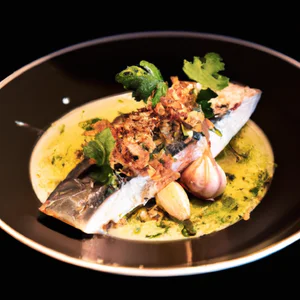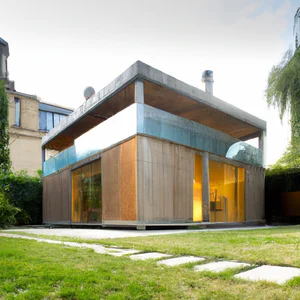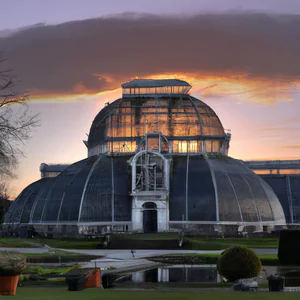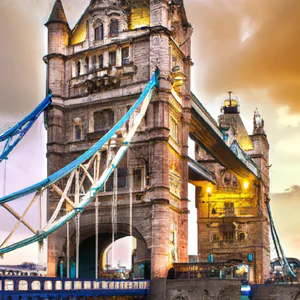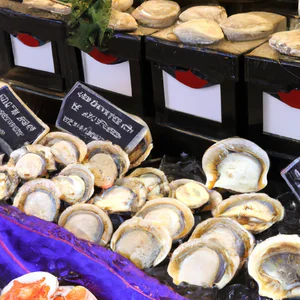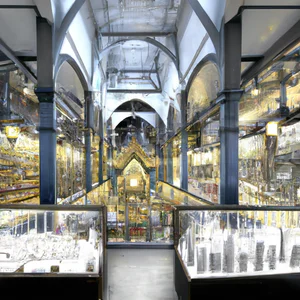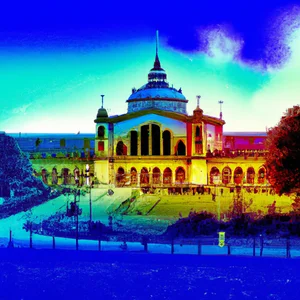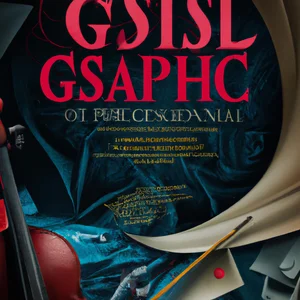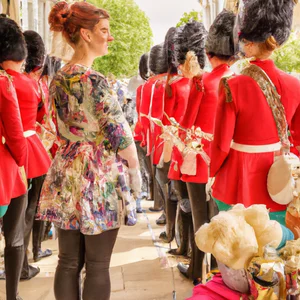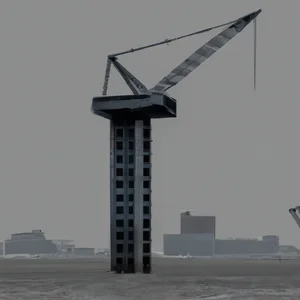Book your experience
The Barbican: Brutalist utopia in the heart of the City
The Barbican, guys, it really is a strange and fascinating place. Imagine finding yourself in the middle of the City of London, surrounded by skyscrapers and modernity, and then, bam! You find yourself in a corner that looks like something straight out of a 1970s science fiction film. It’s as if they decided to plant a piece of brutal utopia amidst all the noise.
When I went there for the first time, I wasn’t sure what to expect. There was this mix of concrete and plants that left me a little taken aback. It’s as if they wanted to say: “Hey, nature and architecture can get along!” But, let’s face it, not everyone likes it. Some find it a little too much, like a plate of spaghetti without sauce – in short, a little dry.
The angular lines of the buildings, the terraces that seem to float… It’s all so bold and, at times, a little disturbing. I remember that while I was walking there, I felt like I was in a concrete labyrinth, every corner a little different from the other. And, I don’t know, but there was also a somewhat magical atmosphere, as if time had stopped. Maybe that’s why there are always so many people taking selfies, as if they wanted to capture that surreal moment.
And then there is the culture! There are theatres, art galleries, and even a cinema showing arthouse films. In short, it is like a microcosm inside the city. I think if you’ve never been, you should really check it out. But, be careful, don’t expect the classic. Here you can breathe a different atmosphere, a bit like when you eat a plate of spicy curry and discover that you have fallen in love with the flavour.
To conclude, the Barbican is a place that makes you think. It’s a bit like a book that you start reading and can’t put down, even if it sometimes leaves you perplexed. I’m not sure, but I think it’s worth visiting at least once, even just to see if it has the same effect on you. So, what do you think? Ready to discover this brutalist utopia?
Discover the Barbican: a unique brutalist icon
An Encounter With Brutalism
The first time I stepped into the Barbican, I felt like I had entered another world. The atmosphere was thick with a raw and unexpected beauty, with its imposing concrete buildings standing like monuments to a bygone era. I remember walking along the elevated walkways, surrounded by a symphony of sounds: the rustling of the leaves of the trees in the garden, the echoing footsteps of other visitors and, in the distance, the sound of concerts taking place at the Barbican Centre. This space is not just a residential and cultural complex; it is a bold statement of an architectural era that continues to spark debate and admiration.
Practical Information
Located in the heart of the City of London, the Barbican is easily accessible by tube (Barbican stop) and offers a range of activities for visitors. The complex is open every day, and access to the gardens and public areas is free, but to visit the Barbican Center and temporary exhibitions it is advisable to book in advance. For updates on events and exhibitions, you can visit the Barbican’s official website here.
An Insider Tip
One of the Barbican’s best kept secrets is its library, a true oasis of tranquility. Often overlooked by tourists, it offers a quiet and welcoming atmosphere, perfect for leafing through a book or simply relaxing. Here, you can find a selection of works of art and architecture that can enrich your understanding of this bold style.
Cultural and Historical Impact
The Barbican is an iconic example of Brutalist architecture, a movement that originated in the 1950s and 1960s. This stylistic choice was not only an aesthetic question, but also an attempt to address the problem of post-war reconstruction. The complex was designed as an urban utopia, a place where the community could thrive. Today, the Barbican is not only an architectural symbol, but also a cultural center of international importance.
Sustainability at the Barbican
The Barbican adopts sustainability practices, such as the use of recycled materials and the implementation of vertical gardens which enhance the biodiversity in the area. This approach not only preserves the environment, but also encourages visitors to reflect on the importance of responsible tourism.
A Unique Atmosphere
Walking through its corridors, you will feel enveloped in a unique atmosphere, where raw concrete blends with nature. The gardens, with their winding paths and fountains, offer a charming contrast to the austere architecture. Every corner seems to tell a story, every walkway invites you to explore more.
Activities to Try
Don’t miss the opportunity to take a guided tour of the Barbican, where experts will take you to discover the architectural details and hidden stories that make this place so special. Plus, if you’re passionate about photography, the Barbican offers countless unique angles and perspectives that capture its essence.
Myths to dispel
A common misconception about the Barbican is that it’s just a cold, impersonal place. In reality, this brutalist icon is a vibrant center of cultural life, where events, concerts and exhibitions reveal a dynamic and welcoming side.
Final reflection
As you walk away from the Barbican, you ask yourself: how can such an austere place convey so much life and creativity? The answer lies in architecture’s ability to evoke emotions and tell stories. The Barbican is not just a complex of buildings, but an experience that invites reflection on the beauty of the brutal and the art of living sustainably in modernity.
Walk in the garden: nature in concrete
A personal experience
I still remember the first time I set foot in the Barbican Centre. As I approached, the grandeur of brutalist concrete intimidated me, yet, once inside, I found myself surprised by the unexpected beauty of its internal gardens. The winding paths, lush plants, and small fountains created a stunning contrast to the stark architecture that surrounded me. It was as if a tropical jungle had found a way to thrive amidst a barren urban landscape.
Practical information
The Barbican Garden is open to the public every day from 9am to 8pm, and entry is free. Don’t miss the opportunity to explore the different green areas, such as the Conservatory, which is home to over 2,000 tropical plants and different species of fish. For further details, you can visit the Barbican’s official website, where you will find updates on current events and exhibitions.
An insider tip
A well-kept secret is that the garden offers spectacular views of some of London’s skyscrapers, but most visitors tend to focus only on the interior of the centre. I advise you to go upstairs and look for a quiet corner where you can admire the view. Bring a book or notebook with you and give yourself a moment of reflection surrounded by greenery.
Cultural and historical impact
The Barbican is emblematic of a period of great architectural and cultural experimentation in London in the 1960s and 1970s. Its creation represented an attempt to unite urban life with nature, a concept that influenced many other architectural works in the UK and beyond. The combination of concrete and greenery not only changed the face of the neighborhood, but also stimulated a debate on how cities can integrate natural spaces into urban contexts.
Sustainability
In an age where sustainability is key, the Barbican stands out for its commitment to preserving green spaces. Not only the garden it promotes biodiversity, but also serves as an important green lung for the surrounding neighborhood. Sustainable gardening practices, such as the use of native plants and rainwater harvesting systems, are examples of how the Barbican is trying to reduce its environmental impact.
Immersion in the atmosphere
Walking among the plants and sculptures, you will be able to hear the rustling of the leaves and the chirping of the birds, elements that almost seem like an acoustic illusion in contrast with the noise of the city below. The light filters through the leaves, creating plays of shadows that make each visit unique. Here, time seems to slow down, inviting you to contemplate the beauty of life that thrives between the cracks of the concrete.
Experience not to be missed
I recommend taking one of the garden’s guided tours, where experts will tell you fascinating stories about the plants and architecture of the Barbican. These experiences are often available in several languages and can be booked directly at the center.
Myths to dispel
A common misconception about the Barbican is that it is a cold and unwelcoming place, but once inside, you will discover a lively and welcoming community. The garden is a hub of activity, where families, artists and nature lovers meet and interact, dispelling the image of a concrete island.
Final reflection
As you wander the paths of the Barbican garden, ask yourself: How can nature coexist with modern architecture to create spaces that nourish both body and soul? In an increasingly urbanized world, the Barbican offers a vision of how we could build more sustainable and livable cities, integrating the beauty of nature into the urban fabric.
Arts and culture: the Barbican Center revealed
The first time I set foot in the Barbican Centre, I felt like an explorer in a labyrinth of art and culture, where every corner is a discovery. I clearly remember the moment I stopped in front of one of the temporary installations displayed in the main gallery. It was an immersive work that combined light, sound and projection, making me feel like I was part of a collective dream. This feeling of connection is what makes the Barbican a unique place not just for art enthusiasts, but for anyone looking for an authentic cultural experience.
Discover the cultural center
The Barbican Center is one of the largest cultural centers in Europe and offers a wide range of events ranging from theater shows to concerts, through contemporary art exhibitions. It is always useful to check the Barbican’s official website (barbican.org.uk) for the latest information on events, as the schedule is constantly changing. The variety of shows offers something for every taste: from ballet performances to cinema screenings of arthouse films.
An insider tip
If you want a truly unique experience, consider attending one of the “Barbican Late”: special after-hours events where the galleries remain open and live concerts, DJ sets and interactive activities. It’s an opportunity to experience the Barbican in a different and more intimate atmosphere, away from the daytime crowds.
Cultural and historical impact
The Barbican Center is not just an entertainment venue; it is a symbol of London culture. Opened in the 1980s, the center has played a crucial role in reinvigorating the city’s cultural scene after a period of decline. Through its distinctive brutalist architecture, it challenged aesthetic conventions, becoming an iconic landmark. Its mission is to make art accessible to all, contributing to an ongoing dialogue on relevant and contemporary topics.
Sustainability and responsibility
In an age where sustainability is key, the Barbican is committed to reducing its environmental impact. Responsible tourism practices are incorporated into the centre’s design and management, with initiatives to reduce waste and promote the use of eco-friendly materials. Participating in events here also means supporting an institution that cares about the future of our planet.
An invitation to explore
If you have time, don’t forget to visit the Barbican Cinema, which offers a selection of rare and classic films, often accompanied by expert talks and presentations. Or, take part in one of the many talks or workshops held, where artists and curators share their creative process and insights.
Myths to dispel
It is common to think that the Barbican is only accessible to a niche of art-savvy people. In fact, the center is designed to welcome everyone, and many of the exhibitions and events are free or affordable. Don’t be intimidated by its imposing appearance; the Barbican is a welcoming and inspiring place for anyone curious to explore.
In conclusion, the Barbican Center is an invitation to reflect on how art and culture can influence our daily lives. Which work or event struck you most in your cultural experience? Next time you are in London, take a moment to immerse yourself in this creative and vibrant world.
Unmissable events: what to do at the Barbican
I still remember my first visit to the Barbican Center during one of its most anticipated events: the London Symphony Orchestra performing a Mahler symphony. The atmosphere was electric, with the brutalist architecture standing tall, almost reflecting the power of the music that was about to fill the room. The rich, immersive sound, combined with the architectural beauty of the location, created an experience I will never forget.
A calendar full of events
The Barbican is not just a cultural centre; it is a true epicenter of artistic and cultural activities. Each year, the Barbican hosts a variety of events ranging from classical music concerts to theater performances, contemporary art exhibitions and film screenings. To stay up to date on upcoming events, I recommend you visit the Barbican’s official website, where you will find a detailed calendar and ticket information.
An insider tip
A secret that few people know about is the program of pop-up events that often take place inside the Barbican. These events, which can range from art installations to poetry reading evenings, are often only announced at the last minute. Follow the Barbican’s social media pages or sign up to their newsletter so you don’t miss out on these unique experiences.
Cultural and historical impact
The Barbican is a symbol of innovation and creativity in London’s cultural landscape. Opened in the 1980s, the center is designed to be a place for meeting and cultural exchange, reflecting the city’s commitment to art and culture. Its brutalist architecture has often been the subject of debate, but it is undeniable that it has played a crucial role in defining London’s cultural identity.
Sustainability and responsibility
The Barbican is not just an events centre, but also a model of sustainability. His commitment to eco-friendly practices includes reducing waste and using sustainable materials in his designs. Participating in Barbican events also means supporting a responsible and conscious initiative.
Experience the atmosphere of the Barbican
Imagine walking the corridors of the Barbican, surrounded by works of art and the buzz of events taking place. Every corner tells a story, every room an emotion. The warm lighting and plants that decorate the interior spaces make you feel like you are in a creative refuge, a place where culture blends with life daily.
An activity worth trying
If you are visiting the Barbican, don’t miss the opportunity to take part in an art or music workshop. These experiences will allow you to completely immerse yourself in the creative atmosphere of the center and get to know its most fascinating details.
Myths to dispel
A common misconception is that the Barbican is only accessible to a niche audience or art experts. In reality, it offers events for all tastes and ages, trying to attract a varied audience. You don’t need to be an expert to enjoy the beauty and diversity of cultural offerings.
A final reflection
Next time you visit London, take a moment to consider the importance of the Barbican not only as a cultural centre, but as a symbol of innovation and sustainability. How would your perspective on an event change if you knew you were supporting an initiative that embraces creativity and respect for the environment?
A cafe with a view: the best places to visit
When I visited the Barbican for the first time, I found myself sipping a cappuccino on the top floor of the Barbican Centre, with a view that stretched across the London skyline. The feeling of being surrounded by a concrete jungle, while the sun filtered through the clouds, made that moment unforgettable. It is precisely in this context that you can discover some of the best cafés with a view in the capital, an experience that combines the palate with the panorama.
Unmissable coffees
Here are some local gems where you can enjoy a coffee, whilst admiring the beauty of the Barbican:
The Conservatory Café: Located within the Barbican’s tropical conservatory, offering a unique and relaxing environment. Here, among exotic plants and colorful flowers, you can sip a tea or coffee, surrounded by nature. Don’t forget to try one of their homemade cakes, a real treat!
The Barbican Center Café: With breathtaking views of the central square, this café is the ideal place to recharge your batteries after visiting the art exhibitions. The menu is varied and includes vegetarian and vegan options, perfect for a light lunch.
Fitzrovia Belle: A short distance from the Barbican, this pub offers a welcoming atmosphere and a selection of high-quality coffees. Their terrace is a great place to enjoy the sun during good weather days.
Unconventional advice
If you want a truly unique experience, try visiting the Barbican Center Café during a special event. Often, during screening or performance evenings, the café becomes a meeting place for artists and art enthusiasts. It’s an opportunity to exchange ideas and make new friends, immersed in a vibrant atmosphere.
The cultural impact
The Barbican is not just a cultural centre; it is also a symbol of how brutalist architecture can find harmony with nature. Cafes overlooking the garden or Barbican square offer a refuge from the bustle of the city, encouraging visitors to reflect on the beauty of the fusion between art and architecture.
Sustainable tourism
Many cafes within the Barbican are committed to using local ingredients and eco-friendly practices. For example, The Conservatory Café takes steps to reduce food waste, making your coffee not only a pleasure, but also a responsible choice.
An experience worth trying
During your visit, don’t miss the opportunity to attend a cooking workshop in the Barbican café. These events offer the opportunity to learn new cooking techniques, while sharing moments of conviviality with other participants.
Myths and misconceptions
A common misconception is that the Barbican is only for art lovers. In reality, it is a place where even those who are not art experts can find a stimulating and welcoming atmosphere. The cafés, open to all, offer an excellent starting point for exploring the wonders of the cultural centre.
Final reflection
Next time you visit the Barbican, ask yourself: How can a simple coffee transform your travel experience? Give yourself time to stop, savor and observe, because sometimes the most memorable experiences are born in moments of pause.
Hidden History: The Meaning of Brutalist Design
A personal experience in the heart of the Barbican
I remember the first time I crossed the threshold of the Barbican, immersed in a world where raw concrete was transformed into architectural poetry. I was walking among her imposing structures when, suddenly, a young artist stopped me to show me a painting of hers inspired by the brutalist architecture of the place. Her passion was contagious and she led me to reflect on how this often misunderstood style had a deep and storied meaning.
The essence of brutalism
Brutalist design, which emerged in the 1950s, evolved as a response to the needs of urbanization and functionality. The term “brutalist” derives from the French “béton brut”, which means raw concrete, and represents an architectural philosophy that celebrates the material in a raw and direct way. At the Barbican, this style finds its fullest expression, with bold geometric shapes and open spaces that invite reflection and interaction. The works of architects such as Chamberlin, Powell and Bon not only created a living space, but also sought to challenge the aesthetic conventions of their time.
An insider tip
A little-known secret is that to truly appreciate the Barbican’s brutalist design, it’s best to visit the complex on weekdays, when the flow of visitors is low. This allows you to explore less traveled corners and discover architectural details that you might otherwise miss. Don’t forget to bring a camera: the light that filters through the openings and the play of shadows create breathtaking scenes, perfect for immortalizing the unique atmosphere of the place.
Cultural and historical impact
The Barbican is not just an example of architecture; it is a symbol of how brutalism can be an art form. Over the years, it has hosted significant cultural events, becoming a hub for artists, musicians and filmmakers. Its design has had a profound impact on the way modern cities approach the concept of public space, encouraging critical reflection on beauty and functionality.
Sustainable tourism practices
In an age where sustainability is crucial, the Barbican is committed to promoting responsible practices. The facility was designed with energy efficiency in mind, and today continues to implement initiatives that reduce environmental impact, such as the use of recycled materials and the promotion of low-impact events.
An activity not to be missed
For an immersive experience, join one of the themed guided tours that chronicle the history and architecture of the Barbican. These tours, led by local experts, offer an in-depth, personal look at details that often remain hidden from visitors.
Myths to dispel
A common misconception about brutalism is that it is ugly or devoid of beauty. In reality, its aim is to provoke emotions and reflections, creating spaces that speak directly to urban life. Those who approach the Barbican with an open mind can discover an intrinsic beauty that defies convention.
A final reflection
As you explore the Barbican, ask yourself: How do I perceive concrete and architecture in my daily life? This place is not just an example of design, but an invitation to reconsider our interactions with the spaces around us. The Barbican invites us to see beyond the visible, to discover the beauty in the ugly and to find a balance between nature and urbanisation.
Sustainability at the Barbican: a responsible model
When I first set foot in the Barbican, I was struck by its bold architecture and the way this seemingly austere space integrates with its surroundings. But what surprised me most was my discovery of its commitment to sustainability. During a visit to the Barbican Centre, whilst enjoying a live music performance, I noticed how the energy of the place was not only cultural, but also ecological. This is an often overlooked aspect, but fundamental to understanding the true essence of this brutalist icon.
A tangible commitment
The Barbican is not only a cultural centre, but also an example of responsible urban development. With its roof garden, which extends over 2.5 hectares, the Barbican has created an urban ecosystem that not only beautifies the area, but actively contributes to local biodiversity. According to the Barbican’s annual report, the garden is home to over 200 species of plants and numerous birds, making it a haven for wildlife in the heart of the city. This is a clear example of how brutalist architecture can coexist with nature, rather than oppose it.
An insider tip
If you really want to immerse yourself in the sustainability of the Barbican, don’t miss a visit to the Barbican Conservatory. This internal garden, often ignored by tourists, is a hidden paradise of tropical plants and exotic fish. Taking one of the guided tours offered by the center will give you a deeper understanding of how the Barbican integrates eco-friendly practices into its daily operations.
The cultural impact
The Barbican is not just an entertainment venue, but a beacon of social innovation. Its brutalist architecture, often criticized for its “cold” appearance, has actually paved the way for important conversations about sustainability and responsible urbanization. This space demonstrated that it is possible to design buildings that are both functional and environmentally friendly, thus influencing other urban developments around the world.
Responsible tourism practices
A key aspect of the Barbican experience is the approach towards sustainable tourism. Events often encourage visitors to use public transport or cycling to get there, thus reducing environmental impact. Furthermore, the Barbican is actively involved in community projects that promote environmental education and ecological awareness.
An activity worth trying
For a unique experience, join one of the urban gardening workshops held at the Barbican. These sessions not only provide the opportunity to learn sustainable gardening techniques, but also promote interaction with other nature and sustainability enthusiasts.
Myths to dispel
A common myth is that brutalist buildings, such as the Barbican, are always uninviting or even oppressive. In fact, their design often aims to create accessible and inclusive public spaces, and the Barbican is a perfect example of how architecture can serve the community.
Final reflection
Next time you visit the Barbican, ask yourself: How can we all contribute to a more sustainable future while enjoying the wonders of culture and art? The beauty of the Barbican lies not just in its form, but also in its commitment to a better tomorrow.
Local experiences: markets and restaurants to try
Walking the streets of the Barbican, you find yourself immersed in a melting pot of cultures and flavors that tell stories of community and creativity. My first visit to this iconic corner of London was marked by an afternoon spent at Exmouth market, a place that perfectly embodies the essence of the Barbican: vibrant, eclectic and surprising. With its colorful stalls and the enveloping scents of ethnic food, I discovered a microcosm that develops every Thursday and Saturday, where local artisans and producers gather to offer their specialties.
Markets: a sensorial journey
Exmouth Market: Here you can find everything from Mexican tacos to Indian curries and artisan desserts. Every dish tells a story, and every bite is an experience that stimulates the senses. Don’t miss the chance to savor the pasta e fagioli prepared by Pasta e Fagioli, a small stand that has earned a stellar reputation among locals.
Borough Market: Although a little further from the Barbican, this market is easily accessible and offers a wide range of fresh produce and delicatessen. It is the ideal place for a lunch break, where you can enjoy a smoked meat sandwich and a fresh cocktail.
Restaurants: a culinary experience
The Barbican isn’t just markets; it is also a hub of restaurants that reflect its bold and innovative spirit.
The Barbican Kitchen: A great place for a relaxed meal, offering seasonal dishes prepared with fresh, local ingredients. Their marinated salmon is a must try.
St. John: Located nearby, this restaurant is famous for its approach to British cuisine. Here you can enjoy dishes such as brawn, a traditional preparation based on pork.
Unconventional advice
If you want an authentic and less touristy experience, I recommend visiting the Café in the Crypt in St. Martin-in-the-Fields, not far from the Barbican. This underground cafe serves delicious dishes at affordable prices, all in a unique atmosphere under the church.
Cultural impact and sustainable practices
The Barbican is an example of how food can bring people together and promote sustainability. Many of the local restaurants and markets adopt eco-friendly practices, such as using locally sourced ingredients and recycling. This not only reduces environmental impact, but also celebrates local culinary traditions.
An activity not to be missed
To get the full Barbican dining experience, take a guided food tour. These tours will take you to the best restaurants and markets, offering you tastes and stories that make every bite even more special.
Myths to dispel
Contrary to what you might think, the Barbican is not just a place for artists and intellectuals, but also a vibrant center of food culture. Often considered an austere area, it is actually a landmark where the community comes together to celebrate diversity.
Final reflection
The Barbican is much more than a housing estate; it is a pulsating ecosystem where food and culture intertwine. Have you ever wondered how a simple meal can reflect the soul of a place? Visit the Barbican and be amazed by the wealth of experiences it offers.
A unique tip: explore the Barbican at night
When I first visited the Barbican, the sun was setting and the warm colors of the sky were starting to dance against the grays and blacks of the Brutalist buildings. It was an unexpected discovery: the Barbican at night has a completely different, almost magical atmosphere. The lights that reflect on the concrete surfaces create a play of shadows and reflections that makes the architecture even more fascinating. I felt like I was walking into a science fiction film, immersed in a world that defies the laws of gravity and logic.
The nocturnal magic of the Barbican
Don’t be put off by the idea that the Barbican is just a concrete maze during the day. At night, the complex transforms. The gardens, which seem like a haven of tranquility, come alive with sounds and lights, while the plants stand out against the night sky. You can walk among the illuminated flowerbeds, listening to the gentle rustle of leaves and the distant noise of urban life. It’s a perfect time to reflect and feel part of the city, away from the daily hustle and bustle.
An insider tip
If you want to make the most of the night-time experience, I recommend visiting the Barbican Centre during one of the special events held throughout the year, such as open-air films or evening artistic performances. These events will not only allow you to immerse yourself in local culture, but will also offer a unique opportunity to see the Barbican in a whole new light. Don’t forget to check the events calendar on the Barbican’s official website to stay up to date.
A significant cultural impact
The Barbican is not just a place to visit; it is a symbol of a cultural and architectural vision that has influenced urban design around the world. Built in the 1960s and 1970s, the Barbican is an example of Brutalist architecture which sought to integrate art, public space and community life. Its existence has contributed to enhancing contemporary culture and promoting an innovative vision of urban life.
Sustainability and responsibility
In an age where sustainable tourism is more important than ever, the Barbican is committed to reducing its environmental impact. Green spaces are designed to be sustainable and are an integral part of the urban redevelopment project. Walking in the night garden is also a way to appreciate the efforts made to integrate nature into the urban context.
Soak up the atmosphere
Imagine sitting on a bench in the Barbican garden while the moon reflects on the water of the ponds. The tranquility of the place is palpable and the lights of London create a fascinating contrast with the brutalist architecture that surrounds you. This is a moment to live and remember, an experience that remains etched in the memory.
An activity not to be missed
If you’re feeling adventurous, don’t miss the opportunity to take a guided night tour. These experiences will lead you to discover little-known corners and fascinating stories that lie behind the walls of the Barbican. It is a way to see the complex with new eyes and to appreciate its profound meaning.
Myths to dispel
One of the most common myths about the Barbican is that it is a cold and inaccessible place. On the contrary, the night reveals its welcoming and vibrant character. It is a place where art and nature intertwine, creating an atmosphere that invites discovery and reflection.
A new perspective
Ultimately, exploring the Barbican at night is an experience that invites you to consider the beauty even in the most unexpected places. Next time you’re in the City, why not plan an evening stroll around the Barbican? You may find that there is much more to this corner of brutal beauty than you thought.
Alternative guided tours: discover the secrets of the Barbican
An experience that changes your point of view
I still remember my first visit to the Barbican, a place that, at first glance, may seem like a labyrinth of concrete and bold geometries. I was there for a simple walk, but my curiosity led me to an alternative guided tour. That decision turned out to be a real journey through time and space. The guide, an expert on Brutalist architecture, revealed stories and anecdotes that I could never have discovered on my own. From the story of the complex’s design to the more hidden aspects of daily life in the Barbican, every word transformed my perception of this architectural monument.
Practical and up-to-date information
For those wishing to immerse themselves in the secrets of the Barbican, several local organizations offer alternative guided tours. One of the most popular is the Barbican Walks, which combine history, art and insights into the cultural life of the place. Tours are available in different languages and can be booked directly on the Barbican Centre’s official website. Always check times and availability, as tours can sell out quickly, especially on weekends. Don’t forget to bring a camera: every corner of the Barbican is a work of art to immortalize!
An insider tip
Here’s a little-known tip: During the tour, ask your guide to show you the Barbican’s famous “Secret Garden”, a hidden corner that offers incredible views and a serene atmosphere, far from the hustle and bustle of the city. This garden is often overlooked by tourists and represents an oasis of tranquility perfect for a reflective break.
The cultural impact of the Barbican
The Barbican is not just a cultural centre, but a symbol of how architecture can influence urban life. Inaugurated in the 1980s, the complex was conceived as a refuge for art and culture in a context of rapid urbanization. Today, it represents an intersection of styles and ideas, a place where contemporary art and history intertwine, attracting visitors from all over the world.
Sustainable tourism practices
Opting for an alternative guided tour is also a step towards more sustainable tourism. Choosing tours led by local guides not only supports the community’s economy, but allows you to learn more about the Barbican’s history and sustainable practices. Many tours include information about the complex’s eco-friendly design and art projects that promote sustainability.
Immerse yourself in the atmosphere of the Barbican
Imagine walking between the stark concrete lines, listening to the sound of your shoes ringing in the silence. The scent of vegetation that makes its way through the cracks in the floor reminds you that, even in an urban context, nature always finds a way to emerge. The light that filters through the strategically positioned openings plays with the shadows, creating an almost dreamlike atmosphere.
An activity worth trying
During the tour, don’t miss the opportunity to visit the Barbican Art Gallery. Depending on the programming, you may peek at unique exhibits and artistic innovations that reflect contemporary trends. Also spend some time exploring the gift shop, which offers works by local artists and sustainable products.
Myths to dispel
A common misconception is that the Barbican is a cold, inhospitable place, dominated by concrete. In reality, the design of public spaces and gardens was designed to invite socialization and discovery. Guided tours will allow you to appreciate the care and vision that gave life to this environment.
A final reflection
After exploring the secrets of the Barbican, I realized that every corner tells a story. The beauty of this place lies not only in its bold architecture, but also in the stories of the people who inhabit and experience it. I invite you to consider: what stories might you discover in a place you’ve already visited, if only you had the curiosity to explore its secrets?

 Architecture and Design
Architecture and Design Cities and Regions
Cities and Regions Culture and History
Culture and History Events and Festivals
Events and Festivals Fashion and Shopping
Fashion and Shopping Food and Wine
Food and Wine Nature and Adventure
Nature and Adventure Unique Experiences
Unique Experiences


















